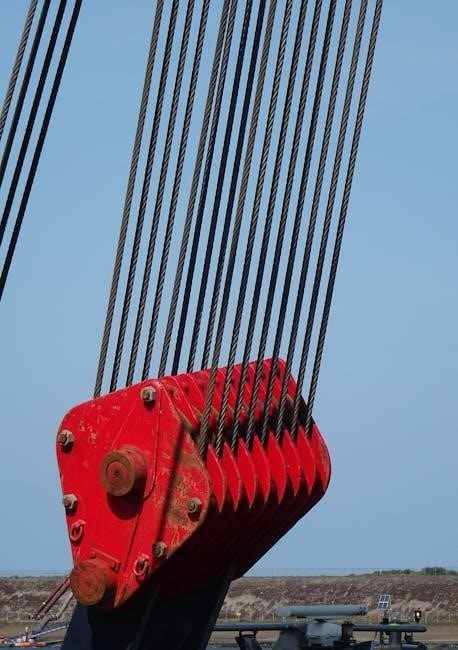A wire rope capacity chart PDF provides a comprehensive guide to wire rope specifications, safe loading, and maintenance, ensuring safety and efficiency in various applications.
1.1 What is a Wire Rope Capacity Chart?
A wire rope capacity chart is a detailed guide that outlines the safe working load limits for various wire rope sizes and configurations. It provides essential information for selecting the right wire rope for specific applications, ensuring safety and efficiency. The chart typically includes data on minimum breaking force, design factors, and sling angles, helping users determine the maximum load a wire rope can safely handle. Available as a PDF, it serves as a quick reference for professionals in lifting, rigging, and construction industries to make informed decisions and comply with safety standards.
1.2 Importance of Wire Rope Capacity Charts in Safety and Efficiency
Wire rope capacity charts are crucial for ensuring safety and efficiency in operations involving lifting and rigging. They provide clear guidelines to prevent overloading, which can lead to accidents and equipment damage. By outlining safe working loads and design factors, these charts help users select the appropriate wire rope for their needs, optimizing performance while minimizing risks. Compliance with safety standards is simplified, and operational efficiency is enhanced. Regular reference to these charts ensures that load capacities are not exceeded, reducing the likelihood of failures and promoting a safer working environment across industries like construction, marine, and heavy machinery. They are indispensable tools for professionals.
Key Factors Affecting Wire Rope Capacity
Key factors affecting wire rope capacity include Minimum Breaking Force (MBF), design factors, and sling angles, ensuring safe and efficient load handling operations.
2.1 Minimum Breaking Force (MBF) and Its Role
The Minimum Breaking Force (MBF) is the minimum or nominal breaking strength of a wire rope, which must be reduced by a design factor to ensure safety. This critical value determines the safe working load capacity of a wire rope sling, ensuring it can handle the intended load without failure. The MBF is a key factor in wire rope capacity charts, as it directly influences the rated load calculations for various sling angles and diameters. Understanding and applying MBF correctly is essential for safe and efficient lifting operations, preventing potential failures and ensuring compliance with safety standards.

2.2 Design Factors and Their Impact on Capacity
Design factors significantly influence wire rope capacity by reducing the Minimum Breaking Force (MBF) to determine safe working loads. These factors vary based on machine type, installation, and permitted operations. For example, in lifting applications, a lower design factor may be applied to ensure additional safety margins. The 6×36/6×37 classification, while offering the same MBF as 6×19 ropes, provides different operating properties like flexibility and resistance to wear, impacting capacity in specific scenarios. Proper consideration of design factors ensures optimal performance and safety, making them a critical component in capacity calculations for various industrial applications.
2.3 Sling Angles and Their Effect on Load Capacity
Sling angles significantly impact wire rope load capacity, with reductions in capacity as angles decrease. For example, a 30-degree angle reduces capacity to 50% of the vertical rating, while a 45-degree angle allows 70%. Horizontal angles below 30 degrees are not recommended due to drastic capacity loss. The rated load for non-standard angles must be calculated by a qualified professional or rounded down to the next lower angle. Proper angle consideration ensures safe and efficient lifting operations, as specified in wire rope capacity charts, to prevent overload and potential failures.

Types of Wire Rope Constructions
Wire ropes are classified into 6×19, 6×36, and specialty constructions, each offering unique strength and flexibility for specific applications, as detailed in capacity charts.
3.1 6×19 Wire Rope Classification
The 6×19 wire rope classification is a popular choice, offering a balance of strength and flexibility. It features 6 strands with 19 wires per strand, providing durability for heavy-duty applications. Known for its resistance to wear and abrasion, this construction is ideal for construction, marine, and industrial settings. The capacity chart details safe working loads for various diameters, ensuring optimal performance. Design factors and sling angles further influence its rated capacity, making it a versatile option for diverse lifting and rigging needs while maintaining safety and efficiency in operations.
3.2 6×36/6×37 Wire Rope Classification
The 6×36 and 6×37 wire rope classifications are known for their flexibility and resistance to fatigue. These ropes consist of 6 strands with 36 or 37 wires per strand, offering enhanced performance in dynamic applications. They share the same weight per foot and minimum breaking force as the 6×19 classification but provide better flexibility and resistance to wear. These constructions are ideal for applications requiring frequent bending and are widely used in construction, heavy machinery, and marine environments. The capacity chart details their safe working loads, ensuring optimal performance and safety in various operational settings.
3.3 Specialty Ropes and Their Applications
Specialty ropes are designed for unique applications requiring specific properties. These ropes are available upon request and are tailored for challenging environments. They often feature enhanced flexibility, corrosion resistance, or high-temperature tolerance, making them ideal for marine, industrial, and heavy-duty applications. Their specialized construction ensures optimal performance in demanding conditions, providing reliable service in niche operational needs. These ropes are commonly used in environments where standard wire ropes may not suffice, ensuring safety and efficiency in specialized lifting and rigging operations. Their unique characteristics make them a critical choice for specific industrial and marine applications.
Wire Rope Sling Capacity Chart Details
Wire rope sling capacity charts detail safe working loads for various diameters, sling angles, and design factors, ensuring optimal performance and safety in lifting operations.
4.1 Safe Working Load Capacities for Different Sling Diameters
Safe working load capacities vary based on sling diameter, construction type, and design factors. Charts provide specific ratings for 6×19 and 6×36/6×37 ropes, ensuring safe operations. Always consult the chart for precise limits.
4.2 Rated Load Calculations for Various Sling Angles
Rated load calculations depend on sling angles, with horizontal angles below 30 degrees not recommended. The capacity at 30 degrees equals a single vertical leg. Charts adjust ratings for different angles, ensuring safe operations across various configurations.
4.3 Horizontal Sling Angles and Their Limitations
Horizontal sling angles below 30 degrees are not recommended due to significantly reduced load capacity. At 30 degrees, the capacity equals a single vertical leg. For angles less than 30 degrees, the rated load must be adjusted or calculated by a qualified professional. This ensures safe operations and prevents overload risks. Always refer to the wire rope capacity chart PDF for specific angle ratings and limitations to maintain safety and efficiency in lifting operations.
How to Read a Wire Rope Capacity Chart
Understand the chart layout and terminology to interpret load capacities for specific rope sizes. Adjust for sling angles and design factors to ensure safe and accurate calculations.
5.1 Understanding the Chart Layout and Terminology
The wire rope capacity chart is organized into tables listing rope sizes, materials, and corresponding safe working loads (SWL). Key terms include Minimum Breaking Force (MBF), design factors, and sling angles. The layout helps users quickly identify capacities for specific applications. Terminology consistency ensures accurate interpretations. Understanding these elements is crucial for safe and efficient operations. Always refer to the chart’s legend for definitions and symbols to avoid errors in load calculations and equipment selection.
5.2 Interpreting Load Capacities for Specific Rope Sizes
Wire rope capacity charts provide detailed load capacities for various rope sizes, materials, and constructions. Users can match their rope size to the chart to determine the safe working load (SWL) for their application. Capacities are typically listed in tables, with columns for rope diameter, minimum breaking force (MBF), and design factors. By cross-referencing these values, operators can ensure they are using the correct rope for the job. Always consider sling angles and other factors when interpreting the chart to avoid exceeding the rope’s rated capacity and ensure safe operations.
5.3 Adjusting for Sling Angles and Design Factors
When interpreting wire rope capacity charts, it’s crucial to adjust for sling angles and design factors. Sling angles significantly impact load capacity, with horizontal angles below 30 degrees not recommended. For angles not listed, use the next lower angle or consult a qualified professional. Design factors, such as the type of machine or installation, also affect the rated load. Always reduce the minimum breaking force by the appropriate design factor to ensure safe operations. This adjustment ensures the rope’s capacity aligns with the specific application, preventing overload and potential failure. Proper adjustments are essential for maintaining safety and efficiency in lifting operations.

Applications of Wire Rope Capacity Charts
Wire rope capacity charts are essential for lifting, rigging, construction, marine, and industrial applications, ensuring safe and efficient operations across various industries.
6.1 Lifting and Rigging Operations
Wire rope capacity charts are critical in lifting and rigging operations, ensuring safe working load capacities and proper design factors for various sling angles. They help determine the appropriate wire rope size and configuration for specific tasks, ensuring compliance with safety standards. By referencing the chart, operators can select the right rope for the job, minimizing risks and optimizing efficiency. The chart also provides guidance on horizontal sling angles, recommending against angles below 30 degrees to maintain structural integrity. This ensures reliable performance in demanding environments, making it an indispensable tool for professionals in the field.
6.2 Construction and Heavy Machinery
Wire rope capacity charts are essential in construction and heavy machinery operations, providing critical data for safe and efficient equipment usage. They detail safe working loads, design factors, and sling angles, ensuring machinery operates within safe limits. By referencing these charts, professionals can select the appropriate wire rope for cranes, hoists, and other equipment, preventing overload and ensuring structural integrity. This is vital in construction projects where heavy loads are lifted, reducing the risk of equipment damage and ensuring compliance with safety standards. Proper wire rope selection, guided by capacity charts, is fundamental to successful and incident-free operations in this demanding industry.
6.3 Marine and Industrial Applications
Wire rope capacity charts are indispensable in marine and industrial applications, ensuring safe and efficient operations. In marine settings, they guide the selection of ropes for mooring, towing, and cargo handling, while in industrial environments, they are crucial for material handling and overhead cranes. The charts provide detailed load capacities, helping professionals choose the right rope size and material for specific tasks. This ensures compliance with safety standards and prevents equipment failure. By adhering to these guidelines, industries can maintain reliability and efficiency, minimizing risks in demanding operational conditions. The charts are a cornerstone for safe and optimal wire rope usage across these sectors.
Safety Guidelines for Wire Rope Usage
Safety guidelines for wire rope usage emphasize adhering to load capacities, regular inspections, and emergency preparedness to prevent failures and ensure operational reliability.
7.1 Pre-Use Inspection Checklist
A pre-use inspection checklist ensures wire ropes are safe for operation. Check for visible damage, wear, or corrosion. Verify proper lubrication and secure attachments. Inspect for signs of overloading or misuse. Ensure the rope’s diameter and lay length match specifications. Look for broken wires, kinks, or birdcaging. Confirm the safe working load (SWL) aligns with the intended application. Document findings and address any issues before use. Regular inspections prevent failures and extend rope lifespan, ensuring compliance with safety standards and operational efficiency.
7.2 Safe Load Limits and Operating Practices

Safe load limits are determined by reducing the Minimum Breaking Force (MBF) by a design factor, ensuring the rope operates within safe parameters. Always reference the wire rope capacity chart to verify load capacities for specific diameters and angles. Operating practices include avoiding overloading, using proper sling angles, and ensuring ropes are free from damage. Proper lubrication and secure attachments are critical. Never exceed the recommended safe working load (SWL), and avoid sudden jerks or shocks. Adhering to these practices minimizes risks, extends rope lifespan, and ensures efficient, incident-free operations.

7.3 Emergency Procedures for Wire Rope Failures
In case of a wire rope failure, immediately evacuate the area and secure the load if possible. Do not attempt to handle the rope under tension. Inspect the rope for visible damage or wear, and document the failure for further analysis. Contact a qualified professional to assess the situation and determine the cause. Ensure all personnel are trained in emergency protocols and understand the risks associated with wire rope failures. Regular maintenance and adherence to safe load limits can help prevent such incidents. Always follow the guidelines outlined in the wire rope capacity chart PDF for proper emergency response.

Maintenance and Inspection of Wire Ropes
Regular inspections, cleaning, and lubrication are crucial for extending wire rope lifespan. Proper storage and handling practices prevent damage, ensuring optimal performance and safety in operations.
8.1 Regular Inspection Techniques
Regular inspections are vital for ensuring wire rope integrity. Visual checks for wear, corrosion, and damage are essential. Inspect for broken wires, abrasion, and corrosion. Measure rope diameter and lay length to detect stretching or compression. Check end fittings and splices for security. Lubricate as needed to prevent friction-related wear. Document findings and replace ropes showing significant degradation. These practices help maintain safety, efficiency, and compliance with industry standards, reducing the risk of sudden failures during operations. Regular maintenance ensures optimal performance and extends the lifespan of wire ropes in various applications.
8.2 Cleaning and Lubrication Practices
Cleaning and lubrication are critical for maintaining wire rope performance. Regularly remove dirt, grease, and debris using solvents or high-pressure water jets to prevent abrasion. Apply lubricants to reduce friction between wires and strands, enhancing flexibility and durability. Use high-quality, penetrating lubricants suitable for the rope’s material and operating conditions. Avoid over-lubrication, as it can attract contaminants. Proper cleaning and lubrication practices extend the rope’s lifespan, reduce wear, and ensure safe operation. These maintenance steps are essential for optimizing wire rope efficiency and preventing premature failure in demanding applications.
8.3 Storage and Handling Best Practices
Proper storage and handling of wire ropes are vital to maintain their integrity. Store ropes in a clean, dry, and cool environment, away from direct sunlight and chemicals. Avoid coiling or bending ropes tightly, as this can cause kinks or damage. Use appropriate lifting techniques to prevent abrasion or crushing. When cutting, ensure clean, square ends to avoid fraying. For long-term storage, apply a rust-inhibiting coating and wrap securely. Always follow manufacturer guidelines for specific rope types. Proper handling and storage extend the rope’s lifespan and ensure optimal performance when in use.
Troubleshooting Common Wire Rope Issues
Identify wear, corrosion, and damage early to prevent failures. Use the wire rope capacity chart PDF for guidance on inspections and maintenance to ensure safe operations.
9.1 Identifying Signs of Wear and Tear
Regular inspections are crucial to detect wear and tear in wire ropes. Look for signs like corrosion, broken wires, and abrasion, which can weaken the rope’s structure. Use the wire rope capacity chart PDF as a reference to assess the rope’s condition. Corrosion can significantly reduce the rope’s strength, while broken wires indicate excessive stress or fatigue. Abrasion from contact with rough surfaces can also compromise safety. If any of these issues are identified, consult the chart to determine if the rope is still within safe working limits or if replacement is necessary to prevent failures and ensure operational safety.
9.2 Addressing Corrosion and Damage
Corrosion and damage significantly reduce wire rope strength, requiring immediate attention. Inspect ropes regularly for rust, pitting, or fraying. Apply lubricants or protective coatings to prevent corrosion. For damaged areas, consider cutting the rope or reducing its load capacity. Refer to the wire rope capacity chart PDF for guidance on safe working limits after damage. If corrosion is severe, replacement is essential to avoid failure. Always prioritize proactive maintenance to extend rope lifespan and ensure operational safety. Addressing these issues promptly helps maintain efficiency and prevents costly downtime or accidents.
9.3 When to Replace a Wire Rope
Replace wire ropes when they show significant wear, corrosion, or damage. If the rope’s diameter is reduced by 5% or more, it’s no longer safe. Severe corrosion, broken wires, or visible strand damage are clear indicators for replacement. Always consult the wire rope capacity chart PDF for specific guidelines. If the rope’s condition compromises its minimum breaking force, it must be replaced immediately. Regular inspections and maintenance can help identify these issues early, ensuring operational safety and preventing unexpected failures. Replacement is crucial to uphold load capacity and avoid potential risks.

Downloading and Using the Wire Rope Capacity Chart PDF
Download the free wire rope capacity chart PDF for detailed specifications, safe loading guidelines, and maintenance tips. It’s an essential resource for efficient and safe operations.
10.1 Where to Find Reliable PDF Resources
Reliable wire rope capacity chart PDFs can be found on official manufacturer websites, industry forums, and trusted platforms like YouTube. These resources provide free downloads, ensuring access to accurate specifications, safe working loads, and design factors. They often include detailed guides for lifting operations, maintenance tips, and application-specific advice. Reputable sources like Wellworth and safety professionals offer comprehensive charts tailored for efficiency and safety. Always verify the source to ensure the information is up-to-date and relevant to your needs. These PDFs are essential for professionals seeking to optimize their wire rope usage in various industries.
10.2 How to Apply the Chart in Real-World Scenarios
To apply a wire rope capacity chart effectively, start by identifying the sling diameter and construction type. Determine the design factor based on the application, then locate the corresponding safe working load. Adjust for sling angles, as capacities decrease with sharper angles. For horizontal angles below 30 degrees, use the next lower rating or consult a professional. Always reduce the minimum breaking force by the design factor to ensure safety. Regularly inspect the rope for wear and corrosion, and refer to the chart for maintenance and replacement guidelines. This ensures optimal performance and safety in lifting and rigging operations.
10.3 Benefits of Using a Digital Version
A digital wire rope capacity chart PDF offers enhanced accessibility and convenience. It can be easily accessed on multiple devices, ensuring availability at any job site. The digital format allows for quick searches and zooming in on details, making it user-friendly. Updates can be instantly applied, keeping the information current. Sharing the chart with team members is straightforward, promoting collaboration. Additionally, digital versions reduce the need for physical storage, saving space and resources. This format is ideal for modern operations, combining efficiency with environmental benefits, while ensuring safety and accuracy in wire rope applications.
